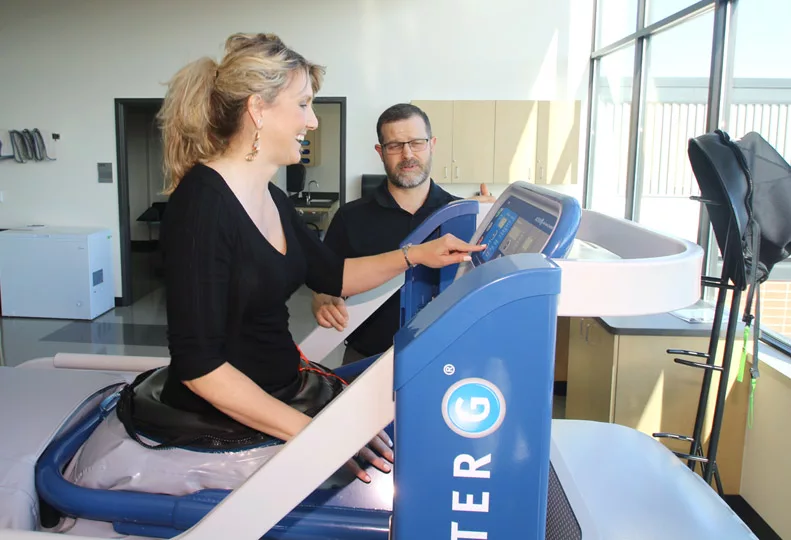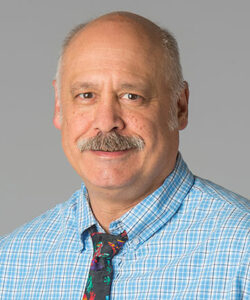EWU, St. Luke's partner to start outpatient physical, occupational therapy clinic
Center promotes hands-on skills for first-year students

Eastern Washington University is partnering with St. Luke’s Rehabilitation Institute in a new physical and occupational therapy clinic in the University District that will provide more opportunities for student training as well as additional patient access to health care.
The 5,400-square-foot physical and occupational therapy clinic is located on the second floor of the Spokane Teaching Health Clinic, at 624 E. Front.
The new clinic, which opened in late April, initially will be staffed with a physical therapist, an occupational therapist, and an admissions coordinator, says Sara Ambrose, St. Luke’s rehabilitation services manager.
St. Luke’s will increase staff at the new clinic as patient numbers grow, Ambrose says. “We could probably have seven or eight therapists here eventually.”
Physical therapy students will begin training at the clinic in July, and occupational therapy students will be brought in the following month, she says.
“The university is still trying to figure out exactly what the contingency of students will be,” Ambrose says.
Christine Clutter, St. Luke’s director of rehabilitation services, says physical therapists focus on restoring or enhancing physical function, flexibility, or mobility, while occupational therapists focus on activities of daily living.
“The occupational therapist will treat the same injury, but the approach is very different,” she says. “The approach might focus on your ability to get dressed in the morning … or doing household tasks that you don’t really think about, but they take strength and mobility.”
The intent for the education component of the clinic is to expose first-year physical and occupational therapy students to the clinical environment.
Ambrose says, “Our hope and our vision is that students early on in their school will learn something in their class and then will be able to come over here and practice.”
Laureen O’Hanlon, dean of EWU’s College of Health Science and Public Health, says the clinic is a significant addition to the college, which is located on EWU’s University District campus, east of downtown.
“EWU’s physical and occupational therapy programs have not had an in-house clinic,” O’Hanlon says. “Students have had to work on each other. Direct student exposure to clinicians and patients before their internship is essential.”
The new clinic also will help with faculty recruitment, because recruits often ask if EWU has a clinic, she asserts.
St. Luke’s will operate the clinic under its business model, and EWU will work with its partners to seek grant funding for treatments and programs that aren’t currently billable, O’Hanlon says. Such programs could include lifestyle medicine, heart-disease prevention, exercise programs, and pain-management alternatives that reduce the need for drugs and hospital admissions, she says.
“We’ll be looking for partners to do things differently to help promote better patient outcomes,” O’Hanlon says.
Interdisciplinary collaboration that includes physical and occupational therapy will reduce costs to the health care system by keeping people in their homes, she asserts.
“I don’t believe any other profession is more skilled in assessing cognitive, physical, and occupational skills to help people live independently,” O’Hanlon says.
EWU’s College of Health Science and Public Health offers eight programs of study, including a doctor of physical therapy and a master of occupational therapy.
The university graduates more than 30 students each from the occupational and physical therapy programs annually.
The collaborative effort at the new clinic also will include participation through EWU’s Health Services Administration and Public Health master’s degree programs, O’Hanlon says, adding that administrative and clinical programs together will improve health care policies and practices.
The new clinic has four private treatment rooms. It also has an observation room that enables students to watch interactions between patients and therapists without disrupting the delivery of patient care.
Much of the new clinic space is occupied by a gym with northward views overlooking the University District.
Clutter says the gym features new equipment to aid in rehabilitating patients with physical and occupational injuries and disabilities.
One new piece of equipment is St. Luke’s first antigravity treadmill.
The $60,000 machine with proprietary technology licensed from NASA uses air pressure to support up to 80 percent of a patient’s weight during treadmill exercises.
“This is a way of rehabilitating somebody who’s had an injury that can’t tolerate full weight,” Clutter says.
The antigravity treadmill also is useful for patients with neuromuscular disorders who might need that support to exercise, she says.
Other gym features include specialized equipment and devices designed to recover and improve patients’ strength, balance, and agility.
The clinic also includes a kitchen and a bathroom designed for occupational therapy patients to practice functional and cognitive tasks.
Ambrose says the clinic hopes to receive a good share of its patient referrals from within the building.
“Anyone who needs physical or occupational therapy could choose to come here,” she says. “We do hope in the spirit of interprofessional care that we get a lot of patients from the residency clinic downstairs.”
The Spokane Teaching Health Clinic, which opened in August, has 67 medical residents in a program operated by Providence Health Care. Medical residents are new physicians who must complete at least three years of training before they can practice medicine without direct supervision.
Ambrose says physicians at the residency clinic have indicated they also would like to observe physical and occupational therapy sessions.
“That also allows our physical therapists and occupational therapists to talk to physicians about what kind of referrals are appropriate and what kind of patients can benefit from therapy,” she says.
The physical and occupational therapy clinic at the Spokane Teaching Health Clinic will be St. Luke’s 10th outpatient clinic.
St. Luke’s main campus, which is located at 711 S. Cowley, includes the largest freestanding rehabilitation hospital in the Spokane area.
St. Luke’s has 650 employees, including nearly 300 physical and occupational therapists, and works with 300 physical and occupational therapy students annually, most of whom are EWU students in their second or third year of training or in their final internships, Clutter says.
At the new clinic, first-year students likely will learn more from interacting with patients than from practicing on each other, she says.
“It’s nice for students to get that practice in really early with actual patients after they’ve learned a skill,” Clutter says. “That’s how they’re going to become more comfortable with it.”
Related Articles
Related Products


_c.webp?t=1763626051)
_web.webp?t=1764835652)

